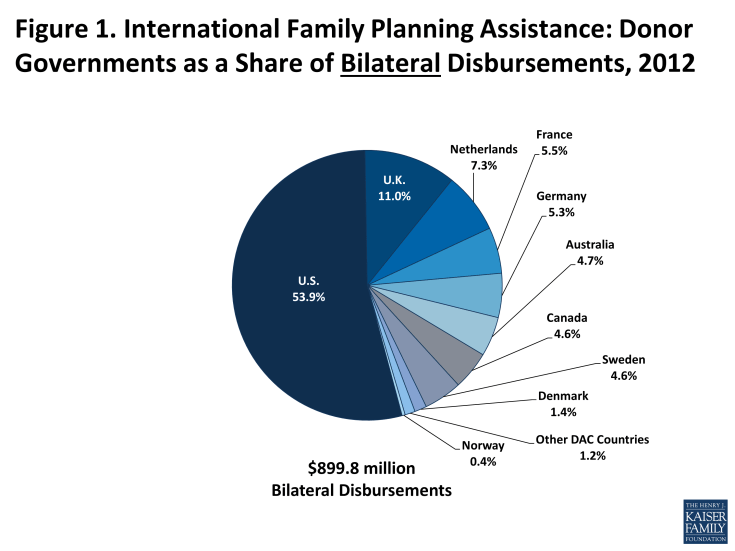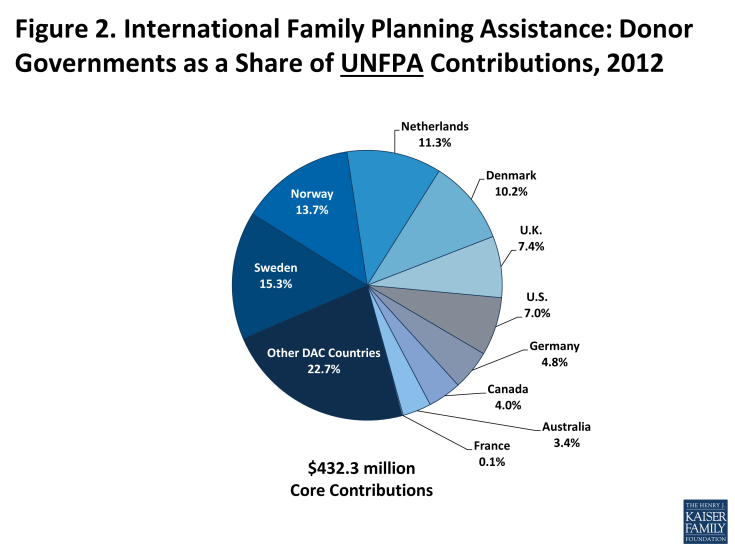Donor Government Assistance for Family Planning in 2012
Introduction
Access to family planning (FP) services has a significant impact on the health and wellbeing of women and girls, and on global health and development more broadly. Family planning – the ability of individuals and couples to determine their desired number of children as well as the timing of and spacing between births – can help prevent pregnancy-related health risks, reduce infant mortality, and help in the prevention of sexually transmitted diseases such as HIV/AIDS.1 Currently, it is estimated that more than 200 million women worldwide would like to delay or stop childbearing, but they do not have access to contraceptives.2 The international community has long recognized the importance of improving access to family planning services. In 1994, at the International Conference on Population and Development (ICPD), 179 governments committed to a 20-year plan of action aimed at providing, among other things, universal access to family planning and sexual and reproductive health services and reproductive rights. Additionally, in 2005, a specific target on reproductive health was added to Millennium Development Goal (MDG) 5, four years after the MDGs were first adopted by Member States of the United Nations. More recently, in July 2012, the U.K. Government and the Bill & Melinda Gates Foundation, in partnership with UNFPA, civil society organizations, developing countries, donor governments, the private sector, and multilateral organizations met at the London Summit on Family Planning and made commitments aimed at providing voluntary family planning services to an additional 120 million women and girls in developing countries by 2020 (see Box 1).
- Provide universal access to family planning and sexual and reproductive health services and reproductive rights.
- Reduce by three quarters, between 1990 and 2015, the maternal mortality ratio;
- Achieve, by 2015, universal access to reproductive health (added in 2005).
- Sustain coverage for the estimated 260 million women in the world’s poorest countries who are currently using contraceptives (as of June 2012); and
- Provide family planning for an additional 120 million women in these countries.A key step in assessing progress towards these goals is tracking expenditures for family planning. While funding from all sources – domestic public and private spending, donor government bilateral assistance, multilateral organizations and private philanthropic (see Box 2) – is critical to helping fulfill international goals and commitments, donor governments provide a significant share of global funding for family planning services.3 Existing efforts to track donor government funding for family planning, however, do not necessarily provide the most recent available data and may not include all forms of assistance.4
Box 2: Other Sources of Funding for FP in Low- & Middle-Income Countries
While this report focuses on donor governments, there are three other major funding streams for FP assistance: multilateral organizations, the private sector, and domestic resources.
Multilateral Organizations: Provide assistance for FP using pooled funds from member contributions and other means. The primary multilateral organization addressing FP is the United Nations Population Fund (UNFPA). Contributions to multilateral organizations are usually made by governments, but can be provided by private organizations and individuals, as in the case of UNFPA. Some multilateral organizations are designed to address specific issues (such as UNFPA, which also finances reproductive health and other population related activities); donor government contributions to UNFPA are highlighted as part of the donor government’s financing effort in this analysis. Donor government contributions to multilateral organizations that are not specifically designed to address population activities, but may include such activities within their broader portfolio (such as the World Bank), are not included in this analysis.
Private Sector: Foundations (charitable and corporate philanthropic organizations), corporations, faith-based organizations, and international non-governmental organizations (NGOs) provide support for FP activities in low- and middle-income countries not only in terms of funding, but through in-kind support; commodity donations; and co-investment strategies with government and other sectors.
Domestic Resources: Including both spending by country governments that also receive international assistance for FP and by households/individuals within these countries, represent a significant and critical part of the response.
This analysis establishes a baseline level of funding in 2012 that can be used to track total international assistance funding levels for family planning over time as well as specific donor government progress in meeting London Summit on Family Planning commitments. It includes an analysis of funding provided by the 24 governments who were members of the Organization for Economic Co-operation and Development (OECD), Development Assistance Committee (DAC) in 2012.5 Of these, eleven made specific commitments at the Summit to increase funding for family planning.1 In addition, there are several other donor governments, particularly the United States and Canada, which, while not making specific commitments at the Summit, also provide funding for family planning activities.
Data for this analysis were collected directly from donor governments and supplemented by the OECD Creditor Reporting System (CRS). For purposes of this analysis, family planning services were defined to include the following activities as specified in the CRS: counseling; information, education and communication (IEC) activities; delivery of contraceptives; capacity building and training.6 Where bilateral family planning funding was included as part of broader reproductive and maternal health activities or other non-health-sector activities, we worked directly with donor governments to identify family planning specific amounts to the extent possible (see Methodology for more information).
Findings
Bilateral Assistance
Donor government bilateral assistance for family planning includes both actual funding amounts provided (e.g., cash transfers) as well as other types of transactions and activities (e.g., technical assistance) and products (e.g., commodities). In 2012, donor governments are estimated to have disbursed7 US$899.8 million in bilateral funding for family planning activities (see Table & Annex).
The United States (US$485.0 million) was the largest bilateral donor in 2012 accounting for more than half (54%) of total bilateral assistance (see Figure 1). The U.K. (US$99.4 million, 11%) was the second largest bilateral donor followed by the Netherlands (US$65.5 million, 7%), France (US$49.6 million, 6%), and Germany (US$47.6 million, 5%).
The eleven donor governments that made commitments at the London Summit on Family Planning (Australia, Denmark, the European Commission, France, Germany, Japan, Korea, the Netherlands, Norway, Sweden, and the U.K.) accounted for US$371.8 million (41%) of total donor government disbursements for family planning in 2012.

Figure 1: International Family Planning Assistance: Donor Governments as a Share of Bilateral Disbursements, 2012
Multilateral Assistance
While the majority of donor government assistance for family planning is provided bilaterally, donors also provide support for family planning activities through multilateral organizations, such as the United Nations Population Fund (UNFPA). Created in 1969, UNFPA supports sexual and reproductive health activities in many low- and middle-income countries and was a key partner in the London Summit on Family Planning (see Box 3).
Box 3: United Nations Population Fund (UNFPA) Mission, Goals, & London Summit on Family Planning Commitment
UNFPA Mission: Deliver a world where every pregnancy is wanted, every birth is safe, every young person’s potential is fulfilled.
UNFPA Goals:
- Achieve universal access to sexual and reproductive health (including family planning);
- Promoting reproductive rights;
- Reducing maternal mortality; and
- Accelerate progress on the ICPD agenda and MDG 5.
UNFPA London Summit on Family Planning Commitment: “UNFPA will double the proportion of its resources focused on family planning from 25% to 40 % based on current funding levels, bringing new funding of at least US $174 million per year from core and noncore funds. This will include a minimum of US $54 million per year, from 2013-2019, in increased funding for family planning from UNFPA’s core resources.”
In 2012, donor governments provided US$432.3 million in core contributions to UNFPA.8 Sweden was the largest donor (US$66.3 million, 15%) followed by Norway (US$59.4 million, 14%), the Netherlands (US$49.0 million, 11%), Denmark (US$44.0 million, 10%), the U.K. (US$31.8 million, 7%), and the U.S. (US$30.2 million, 7%) (see Figure 2).

Figure 2: International Family Planning Assistance: Donor Governments as a Share of UNFPA Contributions, 2012
While it was not possible to calculate an adjusted “family planning share” of UNFPA’s 2012 budget and attribute a portion of a donor government’s UNFPA contribution to family planning specific activities,9 it is important to note the relative balance between a donor’s core-contributions to UNFPA and its bilateral funding for family planning. For instance, three of the ten donor governments profiled provided a larger contribution to UNFPA than their bilateral disbursement: Denmark, Norway, & Sweden.
The eleven donor governments that made commitments at the London Summit on Family Planning (Australia, Denmark, the European Commission, France, Germany, Japan, Korea, the Netherlands, Norway, Sweden, and the U.K.) accounted for US$311.7 million (71%) of total core-contributions to UNFPA in 2012.
Conclusion & Looking Ahead to 2013
The data provided in this analysis provide a baseline level of donor government funding for FP activities in low- and middle-income countries. At the London Summit on Family Planning donors made commitments totaling $2.6 billion in additional funding for family planning.10 While most donor governments have yet to finalize 2013 funding levels, preliminary data indicate two donor governments (the U.K. and Norway) have increased funding for family planning in 2013: U.K. family-planning-specific funding is estimated to be approximately US$105 million, a 5% increase over 2012 levels, and Norway has budgeted approximately $25 million in new family planning-specific funding. In addition, while family-planning-specific funding is not yet available, the Netherlands increased funding in 2013 for “Sexual and Reproductive Health & Rights, including HIV/AIDS” to US$504.1 million. The increases by the U.K. and the Netherlands fulfill their London Summit commitments. As donor governments conclude the 2013 fiscal year, it will be important to track funding for family planning activities in order to determine whether the London Summit commitments are being met.
